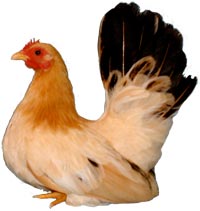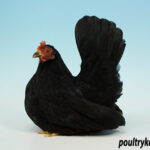
Uses: Exhibition / Ornamental.
Origin: Japan.
Eggs: 80 – 160 white, cream or brown.
Weight: Cock: 510 – 600g, Hen: 400 – 510g.
Colours: Black Tailed White, Black Tailed Buff, Buff Columbian, White, Black, Birchen Grey, Silver Grey, Dark Grey, Millers Grey, Mottled Black, Mottled Blue, Mottled Red, Blue, Lavender, Cuckoo, Red, Tri-coloured, Wheaten Bred, Partridge Bred, Brown Red, Blue Red, Silver and Gold Duckwing.
Useful to Know: A true Bantam that is easy to tame but suffers with a lethal gene combination that causes 25% of chicks to be unable to hatch. Not a hardy bird, can be good fliers. Breeding for good type (especially short legs and correct tail angle) is not easy. For these reasons, not recommended as a beginners bird. Hens make a good broody and can make good mothers. For showing, shape is very important. Only 10 points (out of 100) are available in the British Poultry Standard for colour.
Photo: A rare Black Tailed Buff Hen. Photo courtesy of The Japanese Bantam Club.
Japanese (or Chabo) Bantams are real show birds and go back a long way in history. It is thought that they first arrived in Japan from China in the early 1600s when they started to appear in Japanese paintings.
In Japan, they are called “Chabo”, which means “bantam” or “dwarf” in Japanese but is also the old Japanese name for South-East Asia. They are thought to have reached the UK in the 1860s, and the first Japanese Bantam Club was formed at the Crystal Palace (London) show on 12th November 1912.
The club didn’t have any activity during the two World Wars but resumed activities afterwards. The club was briefly amalgamated to the Frizzle club in 1946, but this didn’t last for long. The present Japanese Bantam Club of Great Britain was formed in 1961.
The annual club show is held at the Reading Bantam Club show and has a strong presence of exhibitors in recent years; the breed has become very popular. They are a true bantam which means they don’t have large fowl counterparts and are very distinctive with very short legs and very long straight vertical tail feathers with a relatively large comb and wings that are held low, touching the ground.
Japanese Bantams should be kept inside on clean, dry bedding except during the best weather to maintain good feather condition. Feathers (especially white) will easily stain the wingtips that drag on the floor if let out in the wet. It is often necessary to provide some additional heat during cold weather unless kept in a reasonably well-insulated building.
Breeding Hints
Japanese Bantams carry the dominant creeper gene Cp which gives the breed short legs. If two short legged birds are bred together, according to Mendals law, 25% of the offspring will be pure for Cp, a lethal gene combination which causes a disability making them unable to hatch. 50% of the offspring will carry one Cp gene and are therefore short legged as per the breed standard and the final 25% will not carry the gene and be long legged. Breeding a short legged with a long legged will produce 50% short legged, 50% long legged without any lethal embryos.
Photos
Books
The following books are available. Links take you to the Amazon or other sellers’ pages for the books.
- Popular Poultry Breeds – D. Scrivener – P.101
- Storey’s Illustrated Guide to Poultry Breeds – C. Ekarius – P.122
- British Poultry Standards – P.142
- American Standard of Perfection – P.249
- Understanding Japanese Bantams – J. K Palin
- Japanese Bantams – Dr. J. Batty
Breed Clubs
These are the breed clubs for Japanese Bantams:
- UK: The Japanese Bantam Club: japclub@ukonline.co.uk
Other True Bantams
Belgian Bantams
No. of Eggs 3.5/5 Easy to Keep? 2.5/5 Uses: Exhibition. Eggs: 200 – 250 tinted / brown.Origin: Belgium.Weight: Cock: 680-790g max, Hen: 570-680g
Booted Bantams
No. of Eggs 2.5/5 Easy to Keep? 2/5 Uses: Exhibition. Eggs: 150 – 180 tinted.Origin: Germany, The Netherlands, Great Britain.Weight: Cock: 850g, Hen:
Dutch Bantams
No. of Eggs 2.2/5 Easy to Keep? 3.5/5 Uses: Exhibition / Ornamental. Eggs: 80 – 160 tinted.Origin: Holland.Weight: Bantam Cock: 500 – 550g,
Pekin Bantams
No. of Eggs 2.2/5 Easy to Keep? 3.5/5 Uses: Exhibition.Origin: Peking, China. Eggs: 120 – 160 White / Cream.Weight: Cock: 680g Max.Hen: 570g Max.Colours: Black, Blue, Buff, Cuckoo, Mottled, Barred,
Rosecomb Bantams
No. of Eggs 2.5/5 Easy to Keep? 3.5/5 Uses: Exhibition. Eggs: 150 – 180 white or cream. Origin: Great Britain. Weight: Cock: 570g
Serama Bantams
No. of Eggs 2.2/5 Easy to Keep? 3.5/5 Uses: Exhibition / Ornamental / Pet. Origin: Malaysia. Eggs: 80 – 160 brown to white.
Sebright Bantams
No. of Eggs 1.1/5 Easy to Keep? 3.5/5 Uses: Exhibition / Ornamental.Origin: England. Eggs: 50 – 80 white.Weight: Cock: 620 g. Hen: 510 g.Colours: Gold, Silver. (Standardised UK).Useful to Know: A true













